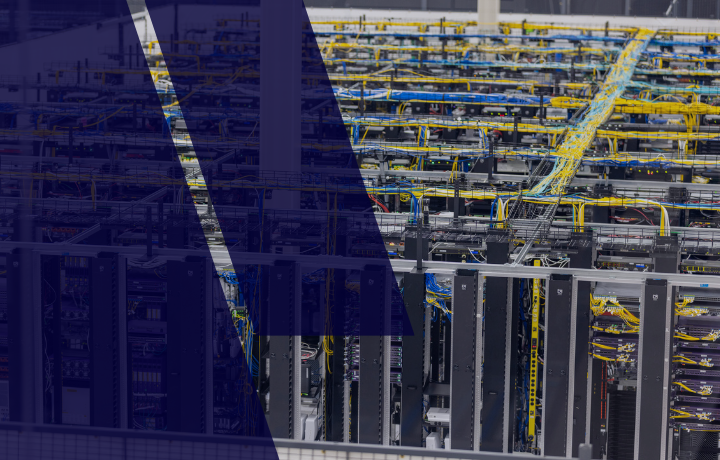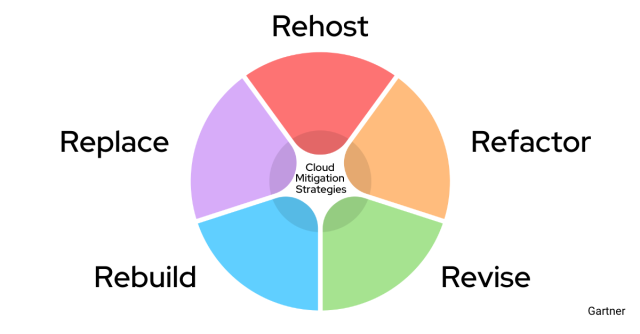Cloud migration strategy: Definition, risks, and mitigation
Migrating to the cloud isn’t just about moving workloads. It’s about having a clear cloud migration strategy that keeps your business secure, efficient, and prepared for what’s next.

Done right, it gives you a clear path to stronger performance, better scalability, and tighter security. Done wrong, it can lead to budget surprises, downtime, or compliance gaps.
In this blog, we’ll walk through what a strong cloud migration strategy looks like, the risks you’ll want to anticipate, and the practical steps you can take to mitigate them, all with insights from how we support our customers every day.
What is cloud migration?
Cloud migration is the process of moving some or all of your digital assets into the cloud, whether that’s from an on-premises setup, a colocation data center, or even another cloud environment. Once workloads are running in the cloud, infrastructure and services are handled by the provider, freeing up your team to focus more on business-enabling initiatives instead of hardware upkeep.
If you’d like to explore this in more depth, we’ve written about advanced cloud migration and how organizations can take greater control of the process.
Types of cloud migration
There are a few common ways to approach a migration, and the right one depends on your priorities:
- Rehosting (“lift and shift”): This is the fastest way to get into the cloud, moving applications over with minimal changes. It’s often chosen when speed matters more than optimization.
- Replatforming: Here, you make a few adjustments during the move, like upgrading a database or operating system, so you can take better advantage of cloud services without fully redesigning your apps.
- Refactoring: This is the deeper investment, re-architecting applications so they’re built to run natively in the cloud. It takes more effort but pays off with long-term flexibility and innovation.
- Hybrid or multi-cloud moves: In some cases, the best answer isn’t one cloud at all. You might combine public and private clouds, or use multiple providers, to balance performance, compliance, and cost.
The trick isn’t just knowing the options, but knowing which one fits your team, your budget, and your timeline.
Why is a robust cloud migration strategy important?
Moving to the cloud offers plenty of upside: greater agility, modernized applications, and stronger support for remote users. But the real differentiator isn’t the migration itself, it’s the strategy behind it. A strong cloud migration strategy ensures you know what to move, how to move it, and how to keep systems secure and cost-effective along the way.
Without that strategy, migrations can easily stall, rack up unexpected costs, or expose critical workloads to downtime and compliance risks. With it, you gain a roadmap that aligns your IT goals with business objectives, reduces surprises, and sets the stage for long-term success. Services like disaster recovery also become easier to integrate when they’re part of the plan from the start.
Benefits of cloud migration for your business
When guided by a solid strategy, cloud migration can deliver measurable value across your organization:
- Enable rapid scalability: The cloud makes it simple to adjust resources to match demand. Retailers, for example, can scale up capacity during peak seasons and scale it back down afterward, avoiding the cost of idle infrastructure.
- Improve agility and flexibility: Digital transformations often hinge on the ability to pivot quickly. The cloud provides that agility, helping organizations accelerate architecture transformation initiatives and move in new directions without the delays of on-premises upgrades.
- Strengthen performance and availability: With cloud IT infrastructure managed by experienced providers, organizations benefit from reliable uptime, proactive maintenance, and broad geographic reach to minimize latency for end users.
- Reinforce security and compliance: Cloud providers invest heavily in protecting environments and keeping them compliant with industry standards, giving organizations access to expertise and safeguards that are often difficult to replicate internally.
- Restore data seamlessly: With services like Disaster Recovery as a Service (DRaaS) and Backup as a Service (BaaS), organizations can recover data and applications quickly, reducing downtime and maintaining business continuity.
- Optimize costs: Instead of paying for peak capacity year-round, businesses can align expenses directly to usage. This “pay as you go” model helps IT leaders rein in costs and better manage budgets.
- Refocus internal IT teams: By offloading infrastructure management, IT teams gain more time to concentrate on initiatives that directly support growth and innovation.
Cloud migration best practices
A successful migration doesn’t happen by chance, as it requires careful planning and execution. These best practices give you a framework to minimize disruption and build lasting value in the cloud.
Build and assess
Before you decide how to move to the cloud, take stock of where you are today. Start by auditing your IT environment: documenting assets, mapping dependencies, and reviewing current usage. This assessment helps uncover risks, define business goals, and set expectations for what you want cloud migration to deliver. Getting this right upfront creates the foundation for every decision that follows.
Strategize and plan for downtime
Every migration is unique, and there’s no “one-size-fits-all” formula. That’s why you need a clear strategy, informed by your assessment, that lays out how data and applications will transition to the cloud. Part of that strategy is understanding whether downtime will be required and, if so, how to minimize its impact. Communicating timelines with both internal stakeholders and end users keeps surprises to a minimum and builds confidence in the process.
Assess the right cloud provider
The skills required for migration, from architecture design to security configuration, can be difficult to build in-house. Choosing the right cloud provider is a critical step. Look for a partner with proven expertise in migrations, strong security practices, and a clear understanding of compliance requirements. The right provider will do more than get you to the cloud; they’ll help ensure your environment is optimized for cost, performance, and long-term growth.
Establish security policies and test
Security can’t be an afterthought in a migration. Before moving workloads, make sure clear policies are in place for identity management, data protection, and regulatory compliance. Define who has access to what, how sensitive data will be encrypted, and how security responsibilities are shared between your team and the provider.
Just as important: test your plan. Running through the migration process in a controlled environment helps you validate each step, confirm security measures are working, and catch potential issues early. This dry run gives you confidence that, when it’s time to move production systems, you’re ready.
Common cloud migration risks
Even with the best intentions, cloud migrations can go off track if risks aren’t identified early. Here are some of the most common pitfalls organizations face.
First, what’s the wrong migration approach?
One of the most common pitfalls in cloud migration is choosing the wrong path — because there’s no one-size-fits-all. Gartner’s latest guidance recommends a balanced framework embodied in a 5‑step migration roadmap: build a solid foundation, avoid cost traps, define governance, align with business objectives, and execute with agility.
Skipping any of these steps can lead to misaligned objectives, surprise expenses, or underleveraged capabilities. Powering ahead without a strategic lens often means you’re not just migrating; you’re rolling the dice.
The 4 R’s of cloud migration
One way to frame migration options is through the 4 R’s, a simplified model many IT leaders use to guide strategy:
- Rehost: Move applications “as is” to the cloud with minimal changes.
- Replatform: Make small optimizations while migrating, like updating a database or OS.
- Refactor: Redesign applications to fully leverage cloud-native services.
- Retire/Replace: Decommission legacy systems or swap them for modern cloud-based solutions.
Highlighting the 4 R’s upfront helps organizations understand that migration isn’t just a single move; it’s a decision about which path best balances cost, speed, and long-term innovation.
Keeping this in mind, here are some common cloud migration risks:
Workloads that are incompatible with cloud
Not every workload is cloud-ready. Legacy applications may not perform well in a hosted environment, and highly regulated industries like healthcare or finance may have compliance requirements that certain providers can’t meet. Forcing these workloads into the wrong environment often results in performance issues, costly repatriation, or regulatory challenges.
Operating applications or storing data in an unsuitable model, whether private or public, can also introduce unwanted latency or create vulnerabilities. Evaluating workload compatibility ahead of time is key to avoiding these setbacks.
Unidentified dependencies
Modern IT environments are highly interconnected. If an application relies on services or systems that aren’t accounted for in the migration, those hidden dependencies can break functionality in the new environment.
The result? Delays, unplanned costs, and potential downtime while teams scramble to trace the issue. Mapping dependencies before migration reduces the risk of unpleasant surprises.
Unrecognized security responsibilities
Cloud security is a shared responsibility between the provider and the customer. While the provider secures the infrastructure itself, the organization must secure its data, applications, and configurations. Failing to define these boundaries can lead to gaps that expose sensitive information or cause noncompliance with regulatory frameworks. Clarity on who manages what is essential from day one.
Increased exposure to downtime and data loss
Any migration carries the risk of temporary downtime or even data loss. Technical missteps, power outages, cyberattacks, or simple human error can all derail the process. Without redundancies and safeguards in place, these incidents can turn into extended outages that disrupt business continuity. A strong cloud migration strategy should always include protections against downtime and tested plans for data recovery.
Loss of control and visibility
When workloads move into a provider-managed environment, organizations sometimes lose the same level of transparency they had on-premises. Limited visibility into performance, resource allocation, or security can lead to inefficiencies and “cloud waste,” AKA paying for unused resources. Choosing solutions that maintain visibility and governance helps organizations stay in control while still taking advantage of cloud benefits.
Mitigation strategies for a successful cloud migration
Every migration carries risk, but the right preparation can significantly reduce it. These strategies help you safeguard workloads and set your cloud deployment up for long-term success.
Engage in in-depth planning
A migration plan shouldn’t just focus on moving workloads; it should evaluate which applications are cloud-ready, which may need updating, and which are best left in the data center. Taking the time to map these details also helps you decide on the right cloud model, whether that’s public, private, or a hybrid mix. Careful planning ensures the move aligns with your broader IT and business goals.
Backup all data before the migration
Data loss is one of the biggest risks during a migration, which makes having a current backup essential. Pre-migration backups ensure you can quickly recover if anything goes wrong in transit. If you want a deeper look at how to protect data effectively, explore our blog on cloud backup and recovery.
Recognize security requirements and responsibilities
Cloud security is shared between you and your provider. To stay compliant and secure, outline your organization’s policies for identity management, data protection, and regulatory requirements before making the move. A strong governance framework, from access controls to incident response, ensures your security responsibilities are met and helps you make the most of the provider’s compliance capabilities.
Leverage a cloud expert
The cloud can be complex, especially if your team doesn’t have deep in-house expertise. Partnering with a trusted cloud provider can reduce risk and accelerate success. An experienced partner helps assess your environment, build the migration plan, execute the move, and validate the new setup so you’re not left to figure it out on your own.
Gain back visibility and control with vCenter access
Migrating doesn’t have to mean giving up control. Solutions like vCenter access let you maintain direct oversight of your environment, with advanced permissions and compatibility with industry-leading tools. That visibility makes it easier to right-size resources, control costs, and keep performance where you need it.
Utilize a phased migration approach
Instead of moving everything at once, start by migrating non-critical workloads. This phased approach allows you to test processes, uncover issues, and make adjustments before business-critical data or applications are moved. It’s a safer, more controlled way to reach the cloud without unnecessary disruption.
Flexential’s approach to a cloud migration strategy
At Flexential, we know that every migration is different and that success depends on more than just moving workloads. It takes the right mix of expertise, planning, and technology to minimize risk while setting your business up for growth.
Our cloud solutions and cloud migration services give you access to experienced consultants who understand the technical requirements, security considerations, and compliance standards that drive a successful migration. We work with you from assessment through execution to ensure your environment is cost-efficient, resilient, and secure.
To support long-term flexibility, we offer multiple deployment options, including Hosted Private Cloud, multi-tenant cloud, and managed public cloud. For customers who need deeper visibility and control, our Advanced vCenter Access solution delivers direct administrative access to VMware vCenter, something no other hosted private cloud provider offers.
This combination of cloud-certified experts, migration services, and flexible environments helps organizations build hybrid IT strategies that balance performance, compliance, and cost. With Flexential, you gain a partner who can not only get you to the cloud but also help you thrive there.
Get support for your cloud migration strategy
A strong cloud migration strategy reduces risk, controls costs, and sets your business up for long-term success. Whether you’re planning your first move or refining an existing deployment, we’re here to help.
Explore our cloud migration resources, learn more about our cloud solutions, or connect with our team to discuss your migration goals. Together, we can design a strategy that’s secure, efficient, and ready for the future.
Cloud migration strategy FAQs
What is a cloud migration strategy and process?
It’s the plan for moving applications, data, and workloads to the cloud in a way that minimizes risk and disruption. A strategy defines what to move, how to move it, and how to secure it.
What are the 4 R’s of cloud migration?
The 4 R’s are Rehost, Replatform, Refactor, and Retire/Replace. Each represents a different path for moving workloads, depending on your goals for speed, cost, and modernization.
What are the key steps in creating a cloud migration strategy?
Typical steps include assessing your environment, mapping dependencies, setting goals, choosing the right provider, planning downtime, and testing before going live.
How do I choose the right cloud service provider?
Look for proven expertise, strong security and compliance practices, and options that fit your business model — whether private or public, hybrid, or multi-cloud.
What are common challenges during cloud migration, and how can they be mitigated?
Challenges include downtime, data loss, cost overruns, and hidden dependencies. Careful planning, backups, phased migration, and working with an experienced partner can help avoid them.
How can I ensure data security and compliance during and after migration?
Define your security responsibilities, enforce access controls, encrypt sensitive data, and align with provider compliance standards from the start.







